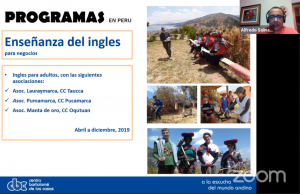Embark on a journey through Barcelona's captivating art and architecture. Explore the visionary works of Gaudí, Picasso, and more, set against the city's stunning landscapes.
GVI
Posted: July 5, 2024

Posted: December 26, 2020
On November 9th, GVI Peru with the Centro Bartolomé de las Casas and The Nature Conservancy held the last online event of 2020. We focused on the volunteer work that we have done for the past two years. In this opportunity, we discussed the different actions we have taken for water protection and how we have supported rural communities in the Piuray micro basin with this matter.
The Piuray micro basin provides 42% of water to the city of Cusco. In other words, most tourists that arrive in Cusco use this natural resource. Also, rural communities give great significance to water. For them, water is a living being that has been present for centuries.
Karol Hermoza, our Program Manager in Peru, discussed the relevance of the partnerships we have established in Cusco and how water conservation was the main topic since GVI arrived in Peru in 2018. CBC and TNC helped GVI to implement all the programs and projects they have. She talked about how green infrastructure is an essential part of GVI work as volunteers have contributed to different projects on this topic. Within our objectives and actions, GVI is trying to mitigate the consequences of climate change, so it is possible to leave a better place for the next generations in the rural communities of Cusco.
As a next guest, we had Alfredo Salinas, a representative from The Nature Conservancy Peru. Alfredo talked about the relevance of the volunteers in Cusco. The cultural exchange was extraordinary and added a new layer of knowledge and experience to the actions related to climate change. The platform to do all this work comes from the project: ‘Adaptation to Water Resources Management to Climate Change’ We can see this project in three regions in Peru: Lima, Piura, and Cusco. Through CBC, they implemented the environmental conservation actions in the Piuray micro basin (Chinchero, Cusco), and with GVI, they were able to agree on volunteer participation.

Due to climate change, there is a need to preserve water sources and evaluate how to recover ecosystems. The project had three objectives: train community members in the significance of water, support public investment through the training of local governments that will lead to a water fund for future projects, and finally, natural infrastructure (reforestation, cleaning of lagoons, recovery of terraces, infiltration ditches, etc.)
The participation from the communities of Cusco has been essential to do more projects than expected. For example, in Lima and Piura, we were only able to fund three projects, while in Cusco, we did seven with the same amount of funds. In other words, the involvement of rural communities has helped to amplify the work. Also, we have to point out the work of the GVI volunteers. During 2019, they recover the Media Luna wetland through a deep clean and a fence that allows better management. Currently, we have recovered some ecosystems, and we see more birds coming to the lagoon. Besides, they supported a greenhouse project at the Pongobamba school, recycling events, and environmental conservation workshops. On the other hand, volunteers have supported English teaching at schools and rural communities to help the rural tourism industry.
We follow the event with Santiago Huarhua, who is president of the Valle Chosica community. He is the representative of 650 community members that commit to environmental preservation. Since last year, CBC has supported their work alongside GVI with the volunteers. As a community, they know water is essential for them, their family, animals, and fields. As years pass by, they realize water is less abundant, and they need better actions to preserve it during the dry season.

Volunteers helped improved the tree nursery. This site is crucial for reforestation in the high zones of the micro basin. We have worked with the community and the volunteers. They expect better outcomes for 2021 as they know the commitments from CBC, GVI, and TNC. Also, community members have set up objectives to plant more native plants and find better ways to preserve water. They know erosion and soil preservation are the next steps to adapt their actions to climate change. Overall, the city of Cusco must understand that we need to work together on water protection. Besides, we cannot forget about agriculture, which has been indispensable during the pandemic. Agriculture has saved us more than tourism. Organic agriculture is the next step to reduce the effects of climate change.
Our efforts are contributing to building better methodologies and actions that can preserve water for the future. It is fundamental to coordinate with local, national, and international partners to achieve outcomes that will allow rural communities to have water for their next genetations.
Embark on a journey through Barcelona's captivating art and architecture. Explore the visionary works of Gaudí, Picasso, and more, set against the city's stunning landscapes.
GVI
Posted: July 5, 2024